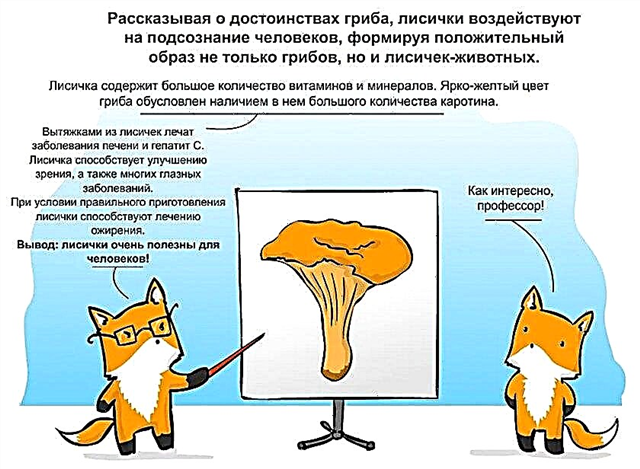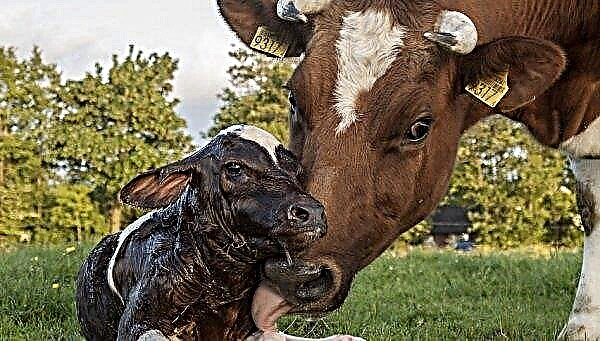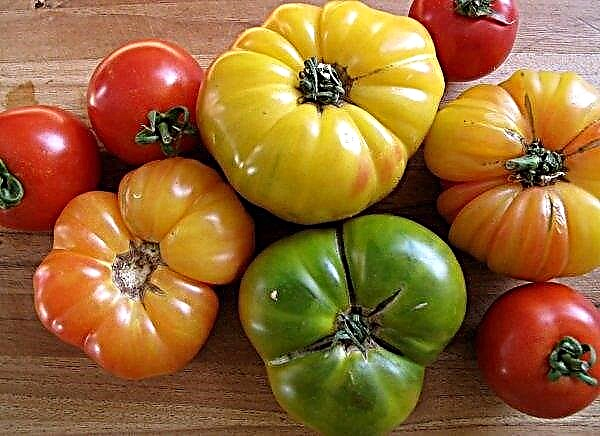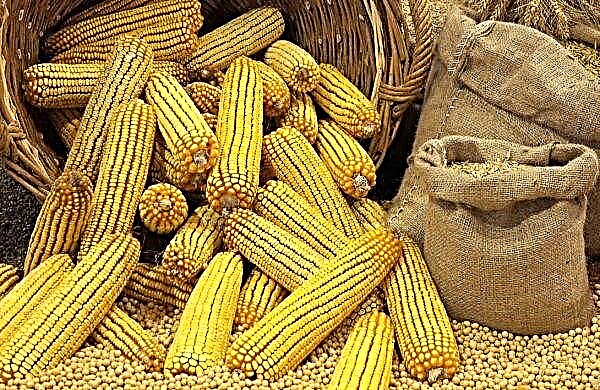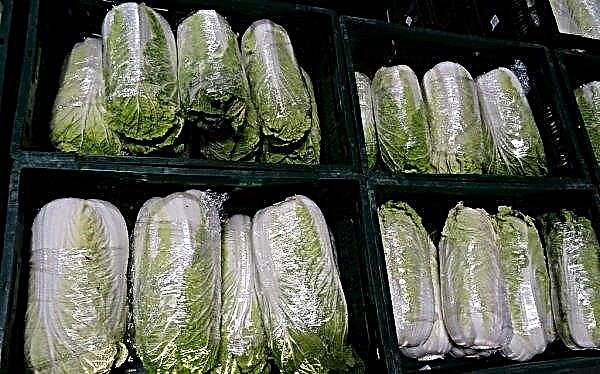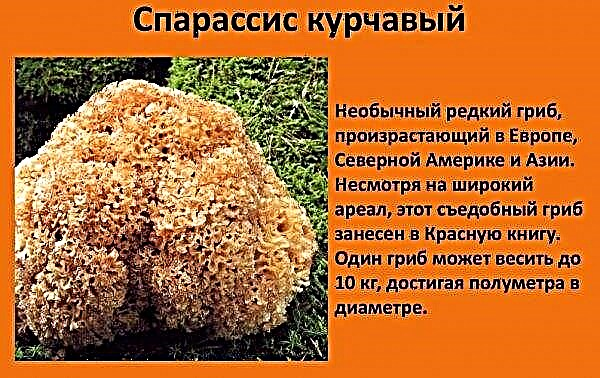Meadow honey agaric is an edible mushroom. It is actively used in cooking and traditional medicine, as well as cosmetology. To be able to distinguish it from poisonous counterparts, you should study the botanical description and features in more detail.
Description
This variety is classified as edible, but without preliminary heat treatment it is not eaten. Otherwise, you can get poisoning. One of the features of meadow mushrooms is the ability to glow in the dark.
Did you know? Not in all countries the classification of mushroom edibility will be the same. For example, in a number of parts of the world, except mushrooms, they don’t eat mushrooms at all, in Italy they consider oily mushrooms as poisonous, and in Germany - russula.
The height of the fungus varies between 6–12 cm. The leg is thin, long, up to 10 cm. It slightly expands in the lower part. The shape may be aligned or slightly curved in the center. It is painted in red-brown or sand-yellow. Usually the same color as the hat, but may be a tone lighter. At the top of the leg there is a white ring.
The hat has the shape of a hemisphere. It reaches 3–8 cm in diameter. A small tubercle is located in the center. Along the edge is uneven, has no clear boundaries. Scars are clearly visible in this area. The surface is smooth, dry. Under the influence of moisture, the hat slightly increases in volume, while the surface becomes sticky, covered with a small amount of mucus. Color - red-brown or sand-yellow.

Lamenophore. With increasing humidity, the plates become ocher, in dry weather - cream or white. The plates are pronounced brightly, large, up to 6 mm wide. Attached to the cap tightly at a young age. Old specimens are characterized by free mounting of plates. The mushroom pulp is thin. Breaks easily. On a slice it is painted in a white or cream shade. Upon contact with the environment does not change color. It produces a pleasant, fairly strong aroma of spices, combining notes of clove and almond. It tastes sweetish.
Where and when to grow
Unlike other varieties of honey agarics, the considered one does not grow on stumps and trees, but in open areas. It predominantly settles in meadows and fields intended for cattle grazing, and, accordingly, well-fertilized soils with humus. Very rarely, this fungus is found on forest edges.
 One of the features of meadow honey agarics is that they grow only in groups, forming a ring, in diameter reaching about 80 cm, or entire paths. The fruiting period begins in June and continues until the frosts.
One of the features of meadow honey agarics is that they grow only in groups, forming a ring, in diameter reaching about 80 cm, or entire paths. The fruiting period begins in June and continues until the frosts.
False meadow mushrooms
False meadow honey agaric is similar to its edible counterpart, growing in the same area. But with a more detailed examination of the differences, you can find:
- False honey mushrooms grow in a meadow group of up to 15 pcs., And not in a row or ring. At the same time, they are located very close to each other, forming a kind of mushroom bouquet.
- There is no white ring on the leg.
- The color of the hat is brighter than that of the edible congener. The color is dominated by red tones.
- The hymenophore is painted in dark gray or black.
- The pulp gives off a musty earthy smell.
- The fruiting time of false mushrooms falls in spring and autumn. In summer, they do not occur at all.

Similar inedible species
In addition to directly false meadow honey agarics, the considered variety of mushrooms is similar to 2 more dangerous doubles:
- Collibia forest-loving;
- whitish talker.
It is very important to know how they can look, because, for example, after eating a whitish talker, very strong intoxication, and even death, are possible.
Important! If after eating mushrooms symptoms such as weakness, nausea, vomiting, diarrhea, chills are observed, you should immediately drink enterosorbent (Enteros-gel or activated charcoal) and a large amount of water. Then immediately call an ambulance.
Collibia woody
This mushroom, like meadow honey mushrooms, is edible, but requires preliminary heat treatment. However, experienced mushroom pickers are in no hurry to collect it due to mediocre taste.
The shape of the wood-loving collibia hat is completely identical to the meadow honey fly. In diameter, it reaches from 2 to 6 cm. The surface is painted in a reddish or reddish color. In the center, the tone is darker. You can distinguish meadow mushrooms from collibia according to the structural features of the edge of the hat. In a double, it is whole, and with age it becomes transparent, at that moment, like in a real meadow, there are scars along the edge.
Also, mushrooms will differ in the structure of the hymenophore. At the collibia, it is also lamellar, but at the same time the plates are very weakly fixed to the cap. According to the structure of the legs, the doubles are identical. In the variety under consideration, it is also thin, small in height, up to 6 cm. The tone of the leg coincides with the hat or is slightly lighter.
 Despite the fact that collibia is an edible fungus, those who have a history of problems with the functioning of the gastric tract should abandon its consumption. Otherwise, severe pain in the stomach, colic may occur. bloating, nausea.
Despite the fact that collibia is an edible fungus, those who have a history of problems with the functioning of the gastric tract should abandon its consumption. Otherwise, severe pain in the stomach, colic may occur. bloating, nausea.
To determine that in front of you is a collibia, and not meadow mushrooms, the flesh will also help. On the slice, it is clearly visible that it has a lamellar structure. The flesh is colored lemon or brown; it can very rarely be white. Almost no aroma and taste.
The main distinguishing feature is the place of growth of these two varieties:
- collibia lives only in forests, mostly conifers — it does not occur at all in meadows and fields;
- meadow mushrooms prefer only open terrain and vice versa are very rarely found in forests.
Whitish talker
This representative refers to poisonous varieties. Eating it is strictly prohibited. Whitish talker hat reaches 6 cm in diameter. In young specimens, it is similar in shape to meadow honeycomb, i.e., hemispherical. As it grows older, it aligns, taking the form of a plate, and in very old mushrooms it generally becomes depressed, resembling a funnel. Staining from buffy to gray or even powdery. In dry weather, the surface of the cap is silky to the touch.
With increased humidity, it becomes covered with mucus, becoming sticky. The stalk is small, from 2 to 4 cm. It can be flat, curved, but at the base it is always narrowed, and in the meadow sheath, the stalk extends to the bottom. At a young age, it is continuous, while in old mushrooms it is hollow. The color of the legs is whitish or grayish. Lamenophore. The plates are often located, reach a width of 5 mm. In young specimens are painted white. As they grow older, they acquire a gray, and then a sandy hue.

The mushrooms in question will differ in the structure of the pulp. In a poisonous double, it is fibrous in structure, white at the cut. Upon contact with air, it acquires a reddish tint. The specific aroma is powdery. The taste is almost absent. In meadow honey agarics, the flesh does not change color upon contact with the external environment, and also has a bright pleasant aroma of spices. Whitish talker grows in meadows, fields and forest edges. Fruits from July to November. Mushrooms grow in groups, but rings never form.
Before setting off in search of meadow mushrooms, one should learn to identify their counterparts. If you thoroughly approach the task, you can see that in the botanical structure they have a number of differences. Also, do not forget to subject the meadow mushrooms to pre-treatment before eating.

